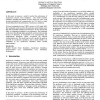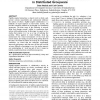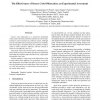832 search results - page 16 / 167 » Effect of Malicious Synchronization |
ICCAD
2001
IEEE
14 years 6 months ago
2001
IEEE
In this paper we propose a model to predict the performance of synchronous discrete event simulation. The model considers parameters including the number of active objects per cyc...
JCS
2006
13 years 9 months ago
2006
In recent years, the threats and damages caused by active worms have become more and more serious. In order to reduce the loss caused by fastspreading active worms, an effective de...
ICCS
2001
Springer
14 years 2 months ago
2001
Springer
This paper surveys and places into perspective a number of results concerning the D-BSP (Decomposable Bulk Synchronous Parallel) model of computation, a variant of the popular BSP ...
CSCW
2008
ACM
13 years 11 months ago
2008
ACM
Tightly-coupled interaction is shared work in which each person's actions immediately and continuously influence the actions of others. Tightly-coupled collaboration is a hal...
IWPC
2009
IEEE
14 years 4 months ago
2009
IEEE
Source code obfuscation is a protection mechanism widely used to limit the possibility of malicious reverse engineering or attack activities on a software system. Although several...



